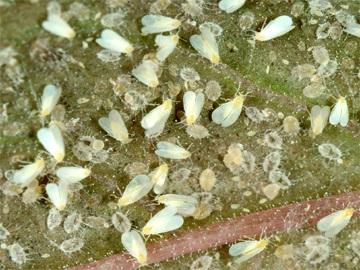|
Greenhouse Whitefly
View more pictures: Bing Images Google Images Yahoo Images Common names: Greenhouse Whitefly, Whitefly, Garden Whitefly, Scientific name: Trialeurodes vaporariorum Region: This whitefly can be found throughout the southern and coastal United States. Life cycle: This insect produces several generations each year and the entire life cycle takes about one month. The flies lay eggs while feeding and hatch within five to seven days. The nymphs or "crawlers" take two weeks to develop. The pupae are a little bigger than the nymph is, and the adult appears in about ten days. Physical Description: The white fly is very tiny. In fact, it measures only about 1/16 of an inch long. They resemble little moths, are white and are covered with a powdery substance. Its eggs are a light yellow with a conical shape and are laid on the underside of young leaves. The green, translucent nymphs, or crawlers, are flat and have fine wax-like filaments. Feeding characteristics: This pest will attack most fruits and garden vegetables. They suck the juice from fresh new growth and cause the plant to weaken and prone to disease. Controls: A very effective control for your home, garden, or greenhouse is the parasite, Encarsia formosa. The parasite is only 1/40 of an inch long and seeks out the nymphs and pupae to lay an egg on its surface. The eggs hatch and the parasite larva attack the inside of the whitefly, turning is black. The parasite is most effective when temperatures are over 70 degrees. It takes them about three weeks to complete its life cycle. Lacewings and Lady Beetles will also prey on the white fly and can be used as backup to the parasites. You can also apply tobacco dust or spray with tobacco tea to help control this pest. Return from Greenhouse Whitefly to Insects E-H Encyclopedia of Garden Insects |
